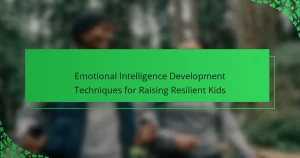
What are Creative Play Ideas for Enhancing Child Development Skills?
Creative play ideas for enhancing child development skills include imaginative role-playing, building with blocks, and engaging in arts and crafts. Role-playing allows children to explore different scenarios, improving their social skills and emotional understanding. Building with blocks fosters spatial awareness and fine motor skills. Arts and crafts encourage creativity and self-expression, enhancing cognitive development. Outdoor play, such as obstacle courses, promotes physical fitness and coordination. Each of these activities has been shown to positively impact various developmental areas, including cognitive, social, and emotional growth.
How do creative play ideas contribute to child development?
Creative play ideas significantly contribute to child development. They enhance cognitive skills by encouraging problem-solving and critical thinking. Engaging in imaginative play fosters creativity and innovation. Social skills also improve as children interact and collaborate during play. Emotional development is supported through role-playing and expression of feelings. Physical coordination and motor skills are enhanced via active play. Research indicates that children who engage in creative play demonstrate better academic performance. A study by the American Journal of Play found that play-based learning leads to improved outcomes in various developmental areas.
What developmental skills can be enhanced through creative play?
Creative play enhances various developmental skills in children. It fosters cognitive skills such as problem-solving and critical thinking. Children engage in imaginative scenarios, promoting creativity and innovation. Social skills are also enhanced through cooperative play and role-playing with peers. Emotional development benefits from expressing feelings and understanding others’ emotions. Fine motor skills improve through activities like drawing and building. Language skills are enriched as children narrate stories and communicate ideas. Research indicates that play-based learning significantly boosts overall child development.
How does creative play differ from traditional play?
Creative play differs from traditional play in its emphasis on imagination and self-expression. Traditional play often follows structured rules and predefined outcomes. In contrast, creative play allows children to explore freely and invent their own narratives. This type of play encourages problem-solving and critical thinking skills. Research indicates that creative play fosters cognitive development more effectively than traditional play. A study by Ginsburg (2007) highlights the importance of unstructured play in enhancing children’s creativity. Additionally, creative play often involves collaboration, promoting social skills and emotional intelligence. Thus, creative play supports a broader range of developmental skills compared to traditional play.
Why is creative play important for children?
Creative play is important for children because it fosters cognitive, social, and emotional development. Engaging in creative play enhances problem-solving skills. Children learn to think critically and explore different solutions through imaginative scenarios. It also promotes social skills by encouraging collaboration and communication with peers. During creative play, children express their feelings and ideas, which aids emotional growth. Research indicates that children who engage in creative play show improved academic performance. According to a study published in the journal “Child Development,” creative play enhances language skills and boosts self-confidence. Thus, creative play is a vital component of holistic child development.
What are the cognitive benefits of creative play?
Creative play enhances cognitive development in children. It fosters problem-solving skills and encourages critical thinking. Children engage in imaginative scenarios, which boosts creativity. This type of play also improves memory and information retention. Research indicates that creative play enhances language skills through storytelling and dialogue. Furthermore, it promotes social skills by encouraging collaboration and negotiation. Studies show that children involved in creative play perform better academically. Engaging in such activities leads to improved focus and attention span.
How does creative play support emotional development?
Creative play supports emotional development by allowing children to express their feelings and explore different scenarios. Through imaginative activities, children can process emotions like joy, anger, and sadness. Engaging in role-playing helps them understand social dynamics and empathy. Studies show that children involved in creative play demonstrate better emotional regulation. For instance, a study published in the Journal of Play Therapy found that creative play reduces anxiety and enhances self-esteem in children. This indicates a direct link between creative play and emotional well-being. Overall, creative play fosters resilience and adaptability in emotional situations.

What types of creative play ideas can enhance child development skills?
Creative play ideas that enhance child development skills include imaginative play, sensory play, and constructive play. Imaginative play allows children to explore roles and scenarios, fostering social and emotional skills. Sensory play engages multiple senses, promoting cognitive development and motor skills. Constructive play, such as building with blocks, enhances problem-solving abilities and spatial awareness. Activities like role-playing, art projects, and nature exploration also contribute to language development and creativity. Research shows that children who engage in diverse play experiences demonstrate improved communication and collaboration skills.
How can arts and crafts facilitate child development?
Arts and crafts facilitate child development by enhancing fine motor skills, creativity, and cognitive abilities. Engaging in activities like drawing, painting, and sculpting requires children to use their hands and fingers, improving dexterity. These activities also encourage imaginative thinking as children express themselves through their creations. Furthermore, arts and crafts promote problem-solving skills. Children must plan and execute their ideas, which fosters critical thinking. Research shows that children who participate in creative activities exhibit better academic performance. A study published in the Journal of Educational Psychology found that children involved in arts education scored higher in math and reading assessments. Overall, arts and crafts provide essential developmental benefits for children.
What specific skills are developed through arts and crafts activities?
Arts and crafts activities develop various specific skills. These include fine motor skills, which enhance hand-eye coordination and dexterity. Creative thinking skills are fostered as children explore different materials and techniques. Problem-solving skills emerge when they encounter challenges during projects. Social skills are improved through collaborative activities with peers. Additionally, communication skills are enhanced as children express their ideas and feelings. Planning and organizational skills are developed by following steps to complete projects. Lastly, self-esteem and confidence grow as children create and share their work. These skills contribute significantly to overall child development.
What materials are best for arts and crafts in child development?
The best materials for arts and crafts in child development include paper, crayons, scissors, glue, and paint. Paper serves as a versatile base for various projects. Crayons encourage creativity and fine motor skills. Scissors help develop hand-eye coordination. Glue fosters cognitive skills through the process of assembling materials. Paint allows for self-expression and sensory exploration. These materials support essential developmental skills such as problem-solving, creativity, and fine motor development. Engaging with these materials has been shown to enhance children’s cognitive and emotional growth.
What role does imaginative play play in child development?
Imaginative play is crucial for child development. It fosters cognitive skills, social abilities, and emotional understanding. During imaginative play, children explore different roles and scenarios. This exploration enhances problem-solving skills and creativity. Research indicates that imaginative play promotes language development. According to a study by Sara Meadows in “The Role of Play in Children’s Development,” children engaged in imaginative play exhibit improved communication skills. Additionally, imaginative play helps children learn to navigate social interactions. They practice empathy and cooperation through role-playing with peers. Overall, imaginative play is a fundamental aspect of healthy child development.
How can role-playing scenarios enhance social skills?
Role-playing scenarios can enhance social skills by providing a safe environment for practice. Participants can simulate real-life interactions and explore various social situations. This practice helps improve communication, empathy, and conflict resolution abilities. Engaging in role-play can also boost confidence in social settings. Studies indicate that children who participate in role-playing demonstrate better social understanding and cooperation. For instance, research by McMahon and Bowers (2006) found that role-playing significantly improved children’s ability to navigate social dynamics. This evidence supports the effectiveness of role-playing in developing essential social competencies.
What are some examples of effective role-playing activities?
Effective role-playing activities include scenarios like doctor-patient interactions, grocery shopping, and community helper roles. These activities engage children in imaginative play. They encourage communication, problem-solving, and social skills. For example, a doctor-patient role-play helps children understand health concepts. Grocery shopping activities teach budgeting and decision-making. Community helper roles foster respect for various professions. Research shows that role-playing enhances cognitive development and emotional intelligence in children. Studies indicate that children who engage in role-playing exhibit improved empathy and social skills.

How can parents and educators implement creative play ideas effectively?
Parents and educators can implement creative play ideas effectively by integrating structured and unstructured activities. Structured activities provide specific guidelines while allowing for creativity. Unstructured activities encourage free exploration and imagination.
Setting clear objectives enhances focus during play. For instance, parents can aim for skill development in areas like problem-solving or teamwork. Educators can create lesson plans that incorporate creative play into the curriculum.
Providing diverse materials stimulates creativity. Items like building blocks, art supplies, and natural elements can inspire innovative thinking. Regularly rotating these materials keeps the play environment fresh and engaging.
Encouraging collaboration among children fosters social skills. Group play activities can enhance communication and teamwork. Parents and educators should also model creative thinking through their own participation in play.
Observing children during play offers insights into their interests and developmental needs. This can guide future play activities. Feedback from children about what they enjoy can inform adjustments to enhance engagement.
Creating a safe and supportive environment is crucial. Children should feel free to express themselves without fear of judgment. This promotes confidence and willingness to explore new ideas.
What strategies can be used to encourage creative play at home?
To encourage creative play at home, provide open-ended materials. Items like cardboard boxes, art supplies, and building blocks stimulate imagination. Set aside dedicated playtime each day to foster creativity. Limit screen time to promote hands-on activities. Create a safe space for exploration and experimentation. Encourage role-playing by providing costumes and props. Engage in collaborative projects to enhance social skills. Offer praise for imaginative ideas to boost confidence.
How can parents create a conducive environment for creative play?
Parents can create a conducive environment for creative play by providing open spaces and diverse materials. Open spaces allow children to move freely and explore. Diverse materials include art supplies, building blocks, and natural elements. These resources inspire imagination and creativity. Parents should minimize distractions, such as screens, during playtime. This encourages focus and deeper engagement. Additionally, parents can join in the play to guide and support their child’s exploration. Research indicates that active parental involvement enhances children’s creative skills. A study by the American Psychological Association found that children with engaged parents show greater creativity in play.
What are some tips for integrating creative play into daily routines?
Incorporating creative play into daily routines can enhance child development skills. Set aside specific times for play, such as after school or during breaks. Use everyday objects for imaginative play, like boxes for building forts. Encourage outdoor activities that stimulate creativity, such as nature scavenger hunts. Integrate art projects into routine tasks, like drawing while waiting for dinner. Create a designated play area to inspire creativity and exploration. Invite friends for collaborative playdates, fostering social skills. Limit screen time to promote active engagement in creative activities. Research shows that regular creative play contributes to cognitive and emotional development in children.
How can educators incorporate creative play into their teaching methods?
Educators can incorporate creative play into their teaching methods by integrating hands-on activities that stimulate imagination. They can use role-playing scenarios to allow students to explore different perspectives. Incorporating art projects encourages self-expression and creativity. Outdoor play can enhance physical skills while promoting teamwork and collaboration. Storytelling sessions can foster language development and critical thinking. Educators can also use games that require problem-solving to engage students actively. Research shows that creative play supports cognitive and emotional growth in children. According to a study by the American Academy of Pediatrics, play is essential for healthy brain development.
What are effective ways to blend creative play with academic learning?
Incorporating creative play into academic learning enhances engagement and retention. One effective method is through project-based learning, where students create projects that require both creativity and research. This approach fosters problem-solving skills and collaboration. Another method is using role-play scenarios related to academic subjects. For example, students can act out historical events to better understand context and significance. Art integration is also valuable; students can express mathematical concepts through drawing or crafting. Additionally, gamifying lessons can make learning more enjoyable. Educational games often promote critical thinking and application of knowledge. Research shows that blending play with learning can improve cognitive development and motivation in children.
How can teachers assess the impact of creative play on student development?
Teachers can assess the impact of creative play on student development through various observation methods. They can observe students during play to identify skills such as problem-solving and teamwork. Teachers can also use checklists to track specific developmental milestones related to creativity. Additionally, reflective journals can be implemented for students to express their experiences and learning outcomes. Peer assessments can provide insights into social interactions during play. Research indicates that creative play enhances cognitive, social, and emotional development in children. For example, a study by Pellegrini and Gustafson (2005) found that children engaged in creative play showed improved social skills and emotional regulation.
What are best practices for maximizing the benefits of creative play?
To maximize the benefits of creative play, encourage open-ended activities that stimulate imagination. Providing diverse materials, such as art supplies, building blocks, and costumes, fosters creativity. Setting up an inviting play environment enhances engagement and exploration. Allowing unstructured time promotes freedom in play, leading to innovative thinking. Participating alongside children can inspire collaborative creativity and strengthen bonds. Regularly rotating materials keeps the play experience fresh and exciting. Observing children during play helps identify interests and tailor activities accordingly. Research indicates that such practices enhance cognitive, social, and emotional development in children.
Creative play is a crucial entity for enhancing child development skills, encompassing activities like imaginative role-playing, building with blocks, and engaging in arts and crafts. These play ideas significantly contribute to cognitive, social, and emotional growth, fostering skills such as problem-solving, creativity, and communication. The article explores various creative play types, including sensory and constructive play, and highlights their developmental benefits, supported by research findings. Additionally, it outlines effective strategies for parents and educators to implement creative play in daily routines and learning environments, maximizing its positive impact on children’s overall development.




